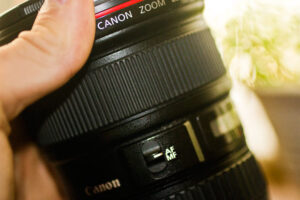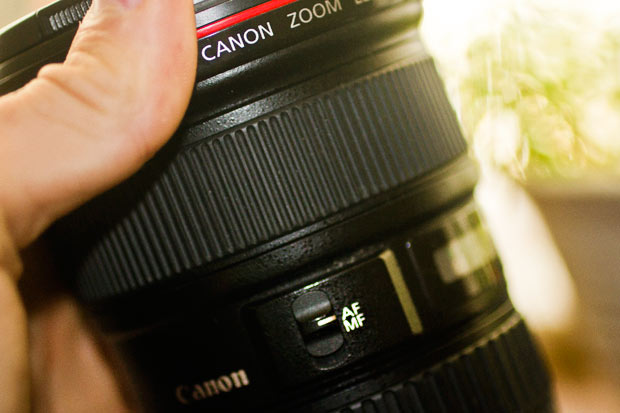We may earn a commission when you purchase through affiliate links. Learn more.
 The autofocus system on modern digital cameras is typically very accurate and impressive, but there are instances where manually focusing a lens is the ideal method.
The autofocus system on modern digital cameras is typically very accurate and impressive, but there are instances where manually focusing a lens is the ideal method.
On interchangeable lens cameras to take your lens off autofocus and switch to manual focus, you will need to locate a small switch on your lens or occasionally on your camera body to change between MF (manual focus) and AF (autofocus). When you are using manual focus, always be sure to check out your results right away by zooming in on the LCD screen. If you’re using a shallow depth of field in particular, what appears to be in sharp focus on a three inch LCD screen might actually be slightly out of focus, so reviewing your shots while you can still take another can really help.
Many modern digital cameras also feature live-view, which allows you to view the scene on your camera’s LCD screen as it will appear in your shot using your exposure settings. You can zoom in on-screen to specific areas while using live mode to make sure that the details are as sharp as possible. Live view is especially useful when you’re shooting tripod mounted shots and can carefully fine tune the focus.
Many older lenses designed for use on 35mm film SLR cameras are perfectly compatible with modern DSLR cameras — the only caveat is that you’re limited to using just manual focus. Older manual focus only lenses can often be purchased at bargain prices, and they’re a great way to practice your photography skills.
Some lenses like those made by Rokinon, Bower, and Samyang which are very popular for astrophotography don’t use any autofocusing circuitry and only work as manual focus lenses. Since astrophotography takes place at night, autofocus would be of no use on these lenses, and the lack of autofocus helps to keep the manufacturing costs very low.

Focusing, whether you’re relying on your camera or your eye to make the adjustments, requires light and contrast. While some newer cameras like the Sony A7s can focus very well in low light conditions, you’ll often find your lens searching for focus without ever finding a point to settle on — you might be able to do a better and quicker job with your eyes. When even you can’t see your subject clearly enough in the low light to establish accurate focus, many lenses also include a very useful distance scale that you can use to estimate focus with. Be sure to review the shot on the LCD screen and zoom in as far as you can since you’ll probably need to fine tune your focus while taking several test shots.
For long exposure photography, manual focus is almost always preferred over autofocus. It’s especially important to remember to switch your lens to manual focus; if you forget and leave it on autofocus, you’ll still be able to focus your lens manually, but after that first shot your lens will try to autofocus once you press on the shutter button again.
If the autofocus system is struggling to lock onto the subject you want it to, give manual focus a shot. This can occur from having either too few areas of contrast in your scene, or from having too many areas of contrast in your scene, causing the camera to be uncertain about what your subject is.
If you’re using thick filters like a neutral density filter, the dark glass can be too dense for the autofocus sensor to get a reading on your scene. You’ll either need to set your focus before attaching the filter, or you can manual focus the shot using live view to carefully focus on your subject. This is especially helpful for shooting long exposure photography.
Macro photography is one of those times when manual focus is almost always the way to go! Because you’re working at such a close range to your subject, even moving a fraction of an inch can mean that your shot will be out of focus. When you’re trying to photograph the tiny hairs on the leg of a fly, manual focus gives you the control you need to get the shot. A tripod will help you fine tune your focus for macro shots, but for those times without a tripod, setting the focus manually will let you move your camera slightly until your subject is perfectly in focus — try shooting a few frames in a row to make sure you got one or two with the focus exactly right. Some photographers even use a technique called photo stacking to combine several macro images, each with a slightly different plane of focus to get a shot where the entire subject is in tack-sharp focus.
Astrophotography takes low light shooting to a new level of darkness! Using autofocus at night to focus on faint stars in the sky is impossible for nearly all cameras, so you’ll need to make use of manual focusing as well as consulting the distance scale on your lens if it has one. Depending upon your camera, live view may be able to help you focus manually, but you’ll most likely need to take several test shots while you refine your focus.
When you’re shooting wide open with a shallow depth of field, manual focus can be very useful. Like macro photography, if you’re close to your subject even a few inches of movement can mean your shot will be painfully out of focus. Using a tripod is an easy way to keep your position steady so that you can achieve that perfect sharp focus.

